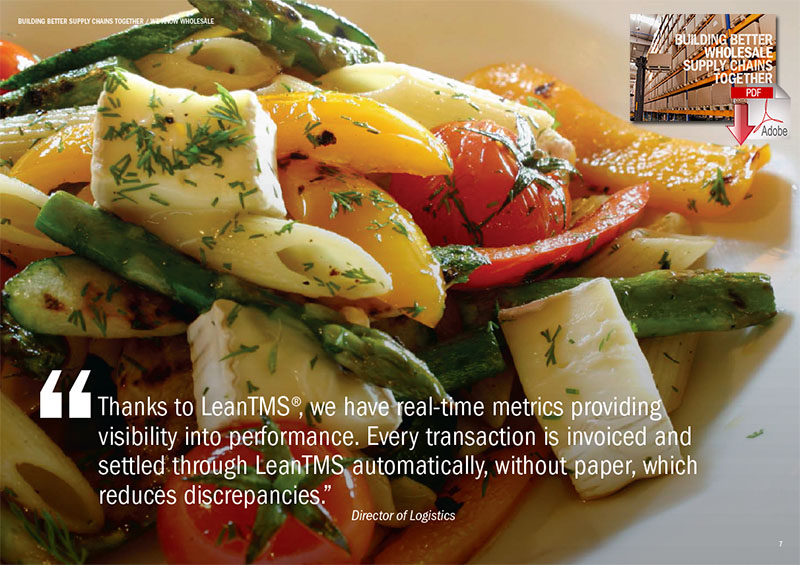Utilizing Transportation Optimization to Design a Smarter Supply Chain

LLamasoft’s Rebecca Koke drops by the LeanLogistics blog to discuss the importance of optimization in creating a transportation strategy
It’s a volatile time in the transportation industry. With the driver shortage and recent West Coast port strikes, changing government regulations, natural disasters of recent years, and the changing landscape of customer demand, getting materials and products from one point to another is becoming more complex each year.
That coupled with internal factors like mergers and acquisitions, adding SKUs and product lines, and globalization, many organizations are struggling to keep pace.
These factors emphasize that the need for a smart and agile transportation strategy is more important than ever. Many of the world’s most successful companies utilize transportation optimization to create and implement a smarter transportation strategy.
How can a company begin designing a better transportation strategy? The challenge can often lie in where to start. A complete overhaul can seem daunting, and organizations may not even be aware of the root cause of inefficiencies. There are hundreds of what-if questions to ask, and the calculations far too complex for spreadsheet-based solutions. Using a transportation modeling tool, analysts can visualize and optimize the as-is transportation network and answer all those what-if questions with a single model.
In order to identify existing inefficiencies and test potential new strategies, they first need to visualize the current end-to-end transportation network. Using data they have collected-even down to the SKU-level-companies can build a living model of their current-state transportation network. Using this model they can analyze their existing network and pinpoint inefficiencies with greater accuracy.
With that “baseline” model complete, as well as a greater understanding of the challenges facing their transportation network, transportation and logistics professionals can then utilize modeling technology to run what-if analyses to test various strategies and tactics for improvement. Those scenarios can range from consolidating shipments, to utilizing multi-stop routes, to developing sailing schedules, to things even as large as selecting a new site for a distribution center or adjusting fleet size. From the risk-free confines of the modeling environment using data from their actual current-state transportation network, organizations can make the smartest possible business decisions to foster success.
The ability to test alternate potential transportation strategies prior to implementing them in the real-world can foster great innovation within a logistics team. Additionally, using scenarios based on real-world data from the existing supply chain, logistics professionals can more easily garner support and buy-in on a new strategy from the larger organization and executive team. And what follows – the ability to develop a logistics strategy that supports your transportation strategy executed through a TMS – will ensure you capture the modeled results.
For example, one major provider of fresh and frozen seafood products wanted to centralize their transportation network instead of having it managed completely by their 3PL. After building a baseline transportation model, the company developed optimal multi-stop outbound distribution routes to deliver frozen seafood from 20+ regional warehouses to more than 1,800 customers throughout the US. Then, they built in a less-than-truckload (LTL) comparison capability to determine the optimal proportion of multi-stop routes and LTL shipments (for small and/or distant remote shipments) for the company’s revised strategy. They were able to uncover approximately 20 percent in outbound transportation cost savings.
Download the Whitepaper: Building Better Wholesale Supply Chains

By adopting transportation optimization as an ongoing business process instead of an ad-hoc project, businesses can design transportation strategies to minimize costs as well, develop living models for continuity planning for planned and unplanned supply chain events, and also encourage innovative and strategic thinking for analysts who will design the transportation networks for future success.
Rebecca Koke is the product manager for Supply Chain Guru at LLamasoft, Inc. Having worked as a transportation product engineer and as a solution consultant for numerous multinational companies, she has a deep knowledge of supply chain logistics and transportation issues. LLamasoft is a trusted LeanLogistics partner and provides software and expertise to design and improve supply chain network operations. LLamasoft combines enterprise-level simulation with full-feature network, transportation, and inventory optimization within a single modeling application.
Click here to learn more about LLamasoft.
Download the Related Whitepapers:
Building Better Wholesale Supply Chains
Building Better Canadian Supply Chains
Building Better Manufacturing Supply Chains
Article Topics
BluJay Solutions News & Resources
5 Signs You May Need a More Modern Supply Chain Solution How Supply Chains are Becoming Resilient Amid Disruptions Supply Chain 2020 Innovation Update BluJay research focuses on the need to build resilient supply chains 5 Signs It’s Time to Modernize Your Supply Chain Technology Supply Chains of the Future Boost the Power of Your Trading-Partner Network More BluJay SolutionsLatest in Technology
Spotlight Startup: Cart.com is Reimagining Logistics Walmart and Swisslog Expand Partnership with New Texas Facility Taking Stock of Today’s Robotics Market and What the Future Holds Biden Gives Samsung $6.4 Billion For Texas Semiconductor Plants Apple Overtaken as World’s Largest Phone Seller Walmart Unleashes Autonomous Lift Trucks at Four High-Tech DCs Talking Supply Chain: Procurement and the AI revolution More Technology















